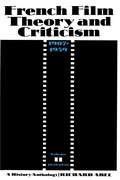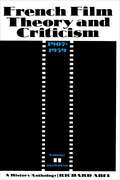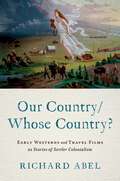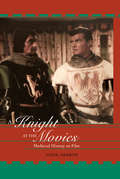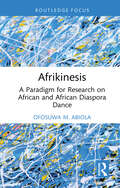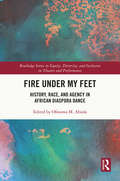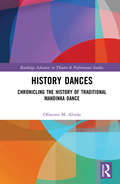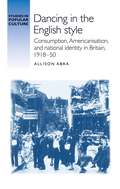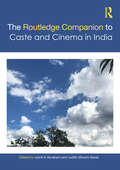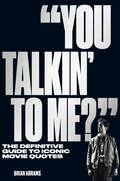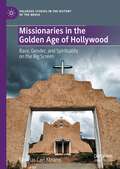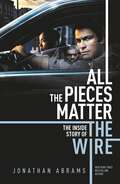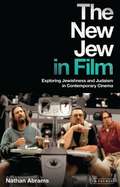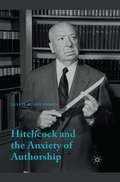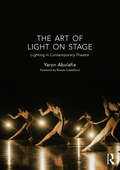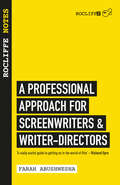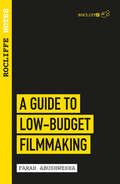- Table View
- List View
French Film Theory and Criticism, Volume 2: 1929-1939
by Richard AbelThese two volumes examine a significant but previously neglected moment in French cultural history: the emergence of French film theory and criticism before the essays of Andr Bazin. Richard Abel has devised an organizational scheme of six nearly symmetrical periods that serve to "bite into" the discursive flow of early French writing on the cinema. Each of the periods is discussed in a separate and extensive historical introduction, with convincing explications of the various concepts current at the time. In each instance, Abel goes on to provide a complementary anthology of selected texts in translation. Amounting to a portable archive, these anthologies make available a rich selection of nearly one hundred and fifty important texts, most of them never before published in English.
French Film Theory and Criticism, Volume 2: A History/Anthology, 1907-1939. Volume 2: 1929-1939
by Richard AbelThese two volumes examine a significant but previously neglected moment in French cultural history: the emergence of French film theory and criticism before the essays of Andr Bazin. Richard Abel has devised an organizational scheme of six nearly symmetrical periods that serve to "bite into" the discursive flow of early French writing on the cinema. Each of the periods is discussed in a separate and extensive historical introduction, with convincing explications of the various concepts current at the time. In each instance, Abel goes on to provide a complementary anthology of selected texts in translation. Amounting to a portable archive, these anthologies make available a rich selection of nearly one hundred and fifty important texts, most of them never before published in English.
Our Country/Whose Country?: Early Westerns and Travel Films as Stories of Settler Colonialism
by Richard AbelThe concept of settler colonialism offers an invaluable lens to reframe early westerns and travel pictures as re-enactments of the United States' repressed past. Westerns in particular propose a remarkable vision of white settlers' westward expansion that reveals a transformation in what "American Progress" came to mean. Initially, these films tracked settlers moving westward across the Appalachians, Great Plains, and Rockies. Their seizure of "empty land" provoked continual resistance from Indigenous peoples and Mexicans; "pioneers" suffered extreme hardships, but heroic male figures usually scattered or wiped out those "aliens." Some films indulged in nostalgic empathy for the Indian as a "Vanishing American." In the early 1910s, westerns became increasingly popular. In Indian pictures, Native Americans ranged from devious savages, victims of white violence, and "Noble Savages" to "in-between" figures caught between cultures and "mixed-descent peoples" partnered for security or advantage. Mexicans took positions across a similar spectrum. In cowboy and cowgirl films, "ordinary" whites became heroes and heroines fighting outlaws; and bandits like Broncho Billy underwent transformation into "good badmen." The mid to late 1910s saw a shift, as Indian pictures and cowgirl films faded and male figures, embodied by movie stars, dominated popular series. In different ways, William S. Hart and Harry Carey reinvented the "good badman" as a stoic, if troubled, figure of white masculinity. In cowboy films of comic romance, Tom Mix engaged in dangerous stunts and donned costumes that made him a fashionable icon. In parodies, Douglas Fairbanks subverted the myth of "American Progress," sporting a nonchalant grin of effortless self-confidence. Nearly all of their films assumed firmly settled white communities, rarely threatened by Indians or Mexicans. Masked as "Manifest Destiny," the expropriation of the West seemed settled once and for all. Our Country/Whose Country? offers a rich and expansive examination of the significance of early westerns and travel pictures in the ideological foundations of "our country."
Our Country/Whose Country?: Early Westerns and Travel Films as Stories of Settler Colonialism
by Richard AbelThe concept of settler colonialism offers an invaluable lens to reframe early westerns and travel pictures as re-enactments of the United States' repressed past. Westerns in particular propose a remarkable vision of white settlers' westward expansion that reveals a transformation in what "American Progress" came to mean. Initially, these films tracked settlers moving westward across the Appalachians, Great Plains, and Rockies. Their seizure of "empty land" provoked continual resistance from Indigenous peoples and Mexicans; "pioneers" suffered extreme hardships, but heroic male figures usually scattered or wiped out those "aliens." Some films indulged in nostalgic empathy for the Indian as a "Vanishing American." In the early 1910s, westerns became increasingly popular. In Indian pictures, Native Americans ranged from devious savages, victims of white violence, and "Noble Savages" to "in-between" figures caught between cultures and "mixed-descent peoples" partnered for security or advantage. Mexicans took positions across a similar spectrum. In cowboy and cowgirl films, "ordinary" whites became heroes and heroines fighting outlaws; and bandits like Broncho Billy underwent transformation into "good badmen." The mid to late 1910s saw a shift, as Indian pictures and cowgirl films faded and male figures, embodied by movie stars, dominated popular series. In different ways, William S. Hart and Harry Carey reinvented the "good badman" as a stoic, if troubled, figure of white masculinity. In cowboy films of comic romance, Tom Mix engaged in dangerous stunts and donned costumes that made him a fashionable icon. In parodies, Douglas Fairbanks subverted the myth of "American Progress," sporting a nonchalant grin of effortless self-confidence. Nearly all of their films assumed firmly settled white communities, rarely threatened by Indians or Mexicans. Masked as "Manifest Destiny," the expropriation of the West seemed settled once and for all. Our Country/Whose Country? offers a rich and expansive examination of the significance of early westerns and travel pictures in the ideological foundations of "our country."
A Knight at the Movies: Medieval History on Film
by John AberthImagining the Middle Ages is an unprecedented examination of the historical content of films depicting the medieval period from the 11th to the 15th centuries. Historians increasingly feel the need to weigh in on popular depictions of the past, since so much of the public's knowledge of history comes from popular mediums. Aberth dissects how each film interpreted the period, offering estimations of the historical accuracy of the works and demonstrating how they project their own contemporary era's obsessions and fears onto the past.
A Knight at the Movies: Medieval History on Film
by John AberthImagining the Middle Ages is an unprecedented examination of the historical content of films depicting the medieval period from the 11th to the 15th centuries. Historians increasingly feel the need to weigh in on popular depictions of the past, since so much of the public's knowledge of history comes from popular mediums. Aberth dissects how each film interpreted the period, offering estimations of the historical accuracy of the works and demonstrating how they project their own contemporary era's obsessions and fears onto the past.
Afrikinesis: A Paradigm for Research on African and African Diaspora Dance (Routledge Advances in Theatre & Performance Studies)
by Ofosuwa M AbiolaThis book provides scholars and non-specialists alike with a roadmap for effectively conducting culturally aware, historically relevant research on African dance and on any dance style that contains African elements. This book explains why Western research paradigms are inadequate for research on Africana dance. It exposes the value of utilizing an appropriate research paradigm that offers researchers a broader perspective and a transparent, unfettered process for analysis in under-researched topics such as African and African diaspora dance styles. Researchers are introduced to the African dance aesthetic, characteristically African body movements, definitions of steps, understandings within African culture, and a host of other jewels that facilitate a deeper grasp on the subject and refine the quality of the scholar’s research, its findings, and its proficiency. This book will be of great interest to scholars of African dance studies.
Afrikinesis: A Paradigm for Research on African and African Diaspora Dance (Routledge Advances in Theatre & Performance Studies)
by Ofosuwa M AbiolaThis book provides scholars and non-specialists alike with a roadmap for effectively conducting culturally aware, historically relevant research on African dance and on any dance style that contains African elements. This book explains why Western research paradigms are inadequate for research on Africana dance. It exposes the value of utilizing an appropriate research paradigm that offers researchers a broader perspective and a transparent, unfettered process for analysis in under-researched topics such as African and African diaspora dance styles. Researchers are introduced to the African dance aesthetic, characteristically African body movements, definitions of steps, understandings within African culture, and a host of other jewels that facilitate a deeper grasp on the subject and refine the quality of the scholar’s research, its findings, and its proficiency. This book will be of great interest to scholars of African dance studies.
Fire Under My Feet: History, Race, and Agency in African Diaspora Dance (Routledge Series in Equity, Diversity, and Inclusion in Theatre and Performance)
by Ofosuwa M. AbiolaFire Under My Feet seeks to expose the diverse, significant, and often under-researched historical and developmental phenomena revealed by studies in the dance systems of the African Diaspora. In the book, written documentation and diverse methodologies are buttressed by the experiences of those whose lives are built around the practice of African diaspora dance. Replete with original perspectives, this book makes a significant contribution to dance and African diaspora scholarship simultaneously. Most important, it highlights the work of researchers from Ecuador, India, Puerto Rico, the United States, and the United Kingdom, and it exposes under-researched and omitted voices of the African diaspora dance world of the aforesaid locations and Puerto Rico, Columbia, and Trinidad as well. This study showcases a blend of scholars, dance practitioners, and interdisciplinarity, and engages the relationship between African diaspora dance and the fields of history, performance studies, critical race theory, religion, identity, and black agency.
Fire Under My Feet: History, Race, and Agency in African Diaspora Dance (Routledge Series in Equity, Diversity, and Inclusion in Theatre and Performance)
by Ofosuwa M. AbiolaFire Under My Feet seeks to expose the diverse, significant, and often under-researched historical and developmental phenomena revealed by studies in the dance systems of the African Diaspora. In the book, written documentation and diverse methodologies are buttressed by the experiences of those whose lives are built around the practice of African diaspora dance. Replete with original perspectives, this book makes a significant contribution to dance and African diaspora scholarship simultaneously. Most important, it highlights the work of researchers from Ecuador, India, Puerto Rico, the United States, and the United Kingdom, and it exposes under-researched and omitted voices of the African diaspora dance world of the aforesaid locations and Puerto Rico, Columbia, and Trinidad as well. This study showcases a blend of scholars, dance practitioners, and interdisciplinarity, and engages the relationship between African diaspora dance and the fields of history, performance studies, critical race theory, religion, identity, and black agency.
History Dances: Chronicling the History of Traditional Mandinka Dance (Routledge Advances in Theatre & Performance Studies)
by Ofosuwa M. AbiolaThe field of history is founded on the interrogation of written documents from the past. However, culture is the center of life in Africa. As a result, in the past – and to a degree in the present – the process for documenting events in Africa was not written, it was performed. History Dances: Chronicling the History of Traditional Mandinka Dance argues that a wealth of information is housed within traditional Mandinka dance and, consequently, the dances can be used as an African-derived primary source for writing African history. Ofosuwa M. Abiola highlights the overall value of studying Mandinka dance history specifically, and African dance history generally, as well as addressing the issue of scarcity with regard to primary sources for writing African history. History Dances proves to be a vital read for both undergraduate students and scholars in the fields of dance history, African history, performance studies, and cultural anthropology.
History Dances: Chronicling the History of Traditional Mandinka Dance (Routledge Advances in Theatre & Performance Studies)
by Ofosuwa M. AbiolaThe field of history is founded on the interrogation of written documents from the past. However, culture is the center of life in Africa. As a result, in the past – and to a degree in the present – the process for documenting events in Africa was not written, it was performed. History Dances: Chronicling the History of Traditional Mandinka Dance argues that a wealth of information is housed within traditional Mandinka dance and, consequently, the dances can be used as an African-derived primary source for writing African history. Ofosuwa M. Abiola highlights the overall value of studying Mandinka dance history specifically, and African dance history generally, as well as addressing the issue of scarcity with regard to primary sources for writing African history. History Dances proves to be a vital read for both undergraduate students and scholars in the fields of dance history, African history, performance studies, and cultural anthropology.
Dancing in the English style: Consumption, Americanisation and national identity in Britain, 1918–50 (Studies in Popular Culture)
by Allison AbraThis book illuminates the history of popular dance, one of the most influential and widespread leisure practices in early twentieth-century Britain. It focuses in particular on the relationship between dancing and national identity construction, in a period when Britain participated in increasingly global markets of popular cultural production, consumption, and exchange.
Dancing in the English style: Consumption, Americanisation and national identity in Britain, 1918–50 (Studies in Popular Culture)
by Allison AbraThis book illuminates the history of popular dance, one of the most influential and widespread leisure practices in early twentieth-century Britain. It focuses in particular on the relationship between dancing and national identity construction, in a period when Britain participated in increasingly global markets of popular cultural production, consumption, and exchange.
The Routledge Companion to Caste and Cinema in India
by Joshil K. Abraham Judith Misrahi-BarakThis companion is the first study of caste and its representation in Indian cinema. It unravels the multiple layers of caste that feature directly and indirectly in Indian movies, to examine not only the many ways caste pervades Indian society and culture but also how the struggle against it adopts multiple strategies. The companion: • critiques Indian cinema production through the lens of anti-caste discourse; • traces the history of films beginning from the early twentieth century, focusing on caste representations across India, including Hindi, Malayalam, Kannada, Marathi, Bengali, Punjabi, Tamil as well as silent films; • makes a foray into OTT media; • includes analysis of popular films such as Padmaavat, Masaan, Fandry, Sairat, Sujata, Article 15, Chomana Dudi, Lagaan, Court, Ee.Ma.Yau, Kaala, Pariyerum Perumal, Perariyathavar, among many others, to critique and problematise the idea of caste. A major intervention, this book alters traditional approaches to ‘caste’ in Indian cinemas and society and explores new political strategies implemented through cinematic creation and aesthetics. It will be indispensable for scholars and researchers of film studies, social discrimination and exclusion studies, human rights, popular culture, and South Asian studies. It will also be of interest to enthusiasts of Indian cinematic history.
The Routledge Companion to Caste and Cinema in India
by Joshil K. Abraham Judith Misrahi-BarakThis companion is the first study of caste and its representation in Indian cinema. It unravels the multiple layers of caste that feature directly and indirectly in Indian movies, to examine not only the many ways caste pervades Indian society and culture but also how the struggle against it adopts multiple strategies. The companion: • critiques Indian cinema production through the lens of anti-caste discourse; • traces the history of films beginning from the early twentieth century, focusing on caste representations across India, including Hindi, Malayalam, Kannada, Marathi, Bengali, Punjabi, Tamil as well as silent films; • makes a foray into OTT media; • includes analysis of popular films such as Padmaavat, Masaan, Fandry, Sairat, Sujata, Article 15, Chomana Dudi, Lagaan, Court, Ee.Ma.Yau, Kaala, Pariyerum Perumal, Perariyathavar, among many others, to critique and problematise the idea of caste. A major intervention, this book alters traditional approaches to ‘caste’ in Indian cinemas and society and explores new political strategies implemented through cinematic creation and aesthetics. It will be indispensable for scholars and researchers of film studies, social discrimination and exclusion studies, human rights, popular culture, and South Asian studies. It will also be of interest to enthusiasts of Indian cinematic history.
"You Talkin' to Me?": The Definitive Guide to Iconic Movie Quotes
by Brian AbramsThis deep dive into hundreds of Hollywood&’s most iconic and beloved lines is a must-have for every film buff."You Talkin&’ to Me?" is a fun, fascinating, and exhaustively reported look at all the iconic Hollywood movie quotes we know and love, from Casablanca to Dirty Harry and The Godfather to Mean Girls. Drawing on interviews, archival sleuthing, and behind-the-scenes details, the book examines the origins and deeper meanings of hundreds of film lines: how they&’ve impacted, shaped, and reverberated through the culture, defined eras in Hollywood, and become cemented in the modern lexicon. Packed with film stills, sidebars, lists, and other fun detours throughout movie history, the book covers all genres and a diverse range of directors, writers, and audiences.
Missionaries in the Golden Age of Hollywood: Race, Gender, and Spirituality on the Big Screen (Palgrave Studies in the History of the Media)
by Douglas Carl AbramsThis book examines major British and American missionary films during the Golden Age of Hollywood to explore the significance of race, gender, and spirituality in relation to the lives of the missionaries portrayed in film during the middle third of the twentieth century. Film both influences and reflects culture, and racial, gender, and religious identities are some of the most debated issues globally today. In the movies explored in this book, missionary interactions with various people groups reflect the historical changes which took place during this time.
All the Pieces Matter: The Inside Story of The Wire
by Jonathan AbramsThe definitive oral history of the iconic and beloved TV show The Wire, as told by the actors, writers, directors, and others involved in its creationSince its final episode aired in 2008, the acclaimed crime drama The Wire has only become more popular and influential. The issues it tackled, from the failures of the drug war and criminal justice system to systemic bias in law enforcement and other social institutions, have become more urgent and central to the national conversation. The show's actors, such as Idris Elba and Dominic West, have gone on to become major stars. Its creators and writers, including David Simon and Richard Price, have developed dedicated cult followings of their own. Universities use the show to teach everything from film theory, to criminal justice and sociology. Politicians and activists reference it when discussing policy. When critics compile lists of the Greatest TV Shows of All Time, The Wire routinely takes the top spot. It is arguably one of the great works of art America has produced in the 21st century.But while there has been a great deal of critical analysis of the show and its themes, until now there has never been a definitive, behind-the-scenes take on how it came to be made. With unparalleled access to all the key actors and writers involved in its creation, Jonathan Abrams tells the astonishing, compelling, and complete account of The Wire, from its inception and creation through its end and powerful legacy.'From the moment The Wire ended, all I have wished for is one more season. Jonathan Abrams has given us something just as valuable — the complete story of how something this wonderful, rich, and intricate came to be' - Mike Schur, creator of Parks and Recreation, Brooklyn 99 and The Good Place'The definitive dissection of television’s most politically meaningful invention' - Chuck Klosterman, New York Times bestselling author of But What if We’re Wrong? and I Wear The Black Hat'Abrams indisputably has created a thorough examination of The Wire’s conception, production, and lingering cultural afterlife' - Publishers Weekly
The New Jew in Film: Exploring Jewishness and Judaism in Contemporary Cinema
by Nathan AbramsJewish film characters have existed almost as long as the medium itself. But around 1990, films about Jews and their representation in cinema proliferated and took on new forms, marking a significant departure from the past. With a new generation of Jewish filmmakers, writers, actresses and actors at work, contemporary cinemas in Hollywood and the rest of the world have been depicting a multiplicity of new Jews, including tough Jews, brutish Jews, gay and lesbian Jews, Jewish cowboys, skinheads and superheroes, and Jews in space.The New Jew in Film is grounded in the study of over 300 films in Hollywood and beyond, including productions from Argentina, Australia, Canada, Germany, Hungary, Italy, Mexico, Russia, Spain, Sweden and the United Kingdom, as well as the United States and Israel. It explores these newand changing depictions of Jews, Jewishness and Judaism, providing a wider, more representative picture of the subject than has hitherto been attempted. This is a compelling, surprising and provocative book, whose chapters explore masculinity, femininity, sexuality, passivity, agency, religion, as well as new territory, including foodand bathrooms. Nathan Abrams's concern is to reveal how the representation of the Jew is used to convey confidence or anxieties about Jewish identity and history, as well as how it engages with questions of racial, sexual and gender politics. Inso doing, he also provides a welcome overview of important Jewish films produced globally over the last twenty years.
Hitchcock & the Anxiety of Authorship
by Leslie H. AbramsonHitchcock and the Anxiety of Authorship examines issues of cinema authorship engaged by and dynamized within the director's films. A unique study of self-reflexivity in Hitchcock's work from his earliest English silents to his final Hollywood features, this book considers how the director's releases constitute ever-shifting meditations on the conditions and struggles of creative agency in cinema. Abramson explores how, located in literal and emblematic sites of dramatic production, exhibition, and reception, and populated by figures of directors, actors, and audiences, Hitchcock's films exhibit a complicated, often disturbing vision of authorship - one that consistently problematizes rather than exemplifies the director's longstanding auteurist image. Viewing Hitchcock in a striking new light, Abramson analyzes these allegories of vexed agency in the context of his concepts of and commentary on the troubled association between cinema artistry and authorship, as well as the changing cultural, industrial, theoretical, and historical milieus in which his features were produced. Accordingly, the book illuminates how Hitchcock and his cinema register the constant dynamics that constitute film authorship.
The Art of Light on Stage: Lighting in Contemporary Theatre
by Yaron AbulafiaThe Art of Light on Stage is the first history of theatre lighting design to bring the story right up to date. In this extraordinary volume, award-winning designer Yaron Abulafia explores the poetics of light, charting the evolution of lighting design against the background of contemporary performance. The book looks at the material and the conceptual; the technological and the transcendental. Never before has theatre design been so vividly and excitingly illuminated. ? The book examines the evolution of lighting design in contemporary theatre through an exploration of two fundamental issues: ? 1.?????? What gave rise to the new directions in lighting design in contemporary theatre? 2.?????? How can these new directions be viewed within the context of lighting design history? ? The study then focuses on the phenomenological and semiotic aspects of the medium for light – the role of light as a performer, as the medium of visual perception and as a stimulus for imaginative representations – in selected contemporary theatre productions by Robert Wilson, Romeo Castellucci, Heiner Goebbels, Jossi Wieler and David Zinder. ? This ground-breaking book will be required reading for anyone concerned with the future of performance.
The Art of Light on Stage: Lighting in Contemporary Theatre
by Yaron AbulafiaThe Art of Light on Stage is the first history of theatre lighting design to bring the story right up to date. In this extraordinary volume, award-winning designer Yaron Abulafia explores the poetics of light, charting the evolution of lighting design against the background of contemporary performance. The book looks at the material and the conceptual; the technological and the transcendental. Never before has theatre design been so vividly and excitingly illuminated. ? The book examines the evolution of lighting design in contemporary theatre through an exploration of two fundamental issues: ? 1.?????? What gave rise to the new directions in lighting design in contemporary theatre? 2.?????? How can these new directions be viewed within the context of lighting design history? ? The study then focuses on the phenomenological and semiotic aspects of the medium for light – the role of light as a performer, as the medium of visual perception and as a stimulus for imaginative representations – in selected contemporary theatre productions by Robert Wilson, Romeo Castellucci, Heiner Goebbels, Jossi Wieler and David Zinder. ? This ground-breaking book will be required reading for anyone concerned with the future of performance.
Rocliffe Notes: A Professional Approach For Screenwriters and Writer-Directors (Rocliffe Notes)
by Farah AbushweshaRocliffe Notes is a compendium for screenwriters and filmmakers which brings together tips and opinions from over 140 film and TV industry professionals, and provides a step-by-step, common-sense guide on how writers and writer-directors can best present themselves to the industry.Including insider insights from award-winning industry players, it details their habits, writing processes, daily passions and preoccupations, whilst also looking at the nuts and bolts of the industry, aiming to motivate writers on their own creative journey, maximise networking opportunities and encourage a professional approach to writing.An essential armament in any writer's store, contributors include: Moira Buffini, Danny Huston, David Parfitt, Jack Thorne, Sarah Gavron, John Madden, John Yorke, Nik Powell, Peter Kosminsky, Christine Langan and Asif Kapadia.'A really useful guide to getting on in the world of film' - Richard Eye'An indispensable addition to the writer's bookshelf' - Lock and load, brides of ChristLook out for the second book in the series: Rocliffe Notes: A Guide to Low Budget Filmmaking.
Rocliffe Notes - A Guide to Low Budget Filmmaking: Taking Your Film from Script to Screen (Rocliffe Notes)
by Farah AbushweshaThe second book in the Rocliffe Notes series, A Guide to Low-Budget Filmmaking is a practical, step-by-step guide to getting your film made, taking it all the way from a script to the screen. It covers every aspect of the process, including: budgeting and finance; casting, crewing and scheduling; shooting and post-production; and marketing and festival strategy. It also incorporates unique insights and insider confidences from peers and established industry players - from directors, writers and producers, through to sales and marketing consultants and distributors. Contributors include: Sean Baker, Saul Dibb, Destiny Ekaragha, Camille Gatin, Sarah Gavron, Shirley Henderson, John Madden, Maxine Peake and Asif Kapadia.A revelation for all would-be filmmakers, it's the essential guide to the nuts-and-bolts of making a film, and a must-have for anyone thinking of making a film on one of the low-budget Microwave, iFeatures or Catalyst schemes, whose recent critical and box-office successes include Lady Macbeth, God's Own Country and The Levelling.'A really useful guide to getting on in the world of film' - Richard Eyre, Writer & Director'This is the book I wish I had when I was started out working in the movies. Would that it had existed a few decades ago. It's detailed, optimistic and full of practical and useful information' - John Malkovich, Actor, Writer & Producer'An insightful and crystal clear read for anyone wanting to produce their first film be it a short or a feature' - Fodhla Cronin O'Reilly, ProducerLook out for the other book in the series: Rocliffe Notes - A Professional Approach for Screenwriters and Writer-Directors.
